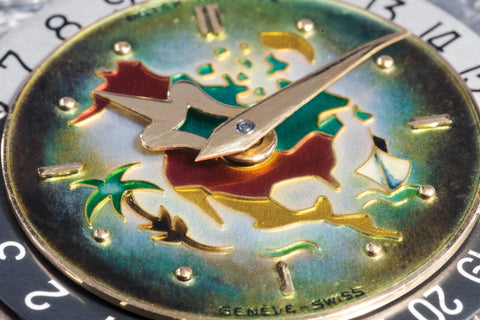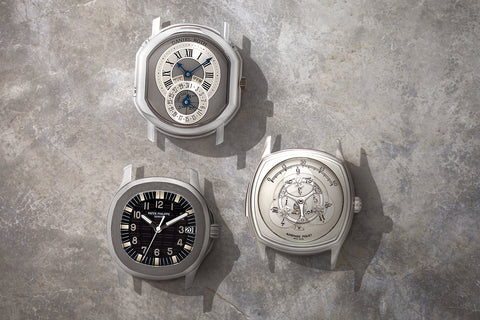The Vacheron Constantin Mercator 2000 reference 43050 was first added to the catalogues in 1994 to mark the 400th anniversary of the death of Gerardus Mercator, a pioneering 16th century geographer and cartographer. He is credited with inventing the map projection, which evolved into the world maps we use today. Produced over a 10-year period, it is understood that only 638 examples left the manufacture.
When it was first introduced, the reference 43050 was a rare example of a watch that paired classical styling with an unconventional time display, depicting the minutes and hours across just about a third of the dial. In this example, the 36mm platinum case is paired with retrograde minutes and hours hands, mounted co-axially, visually reminiscent of a divider used to determine distances between two points on a map. The one on the left indicates the hour on a 12-hour scale arranged on an arc; the minute hand, on the right, glides across a similar 12-point scale, graduated into 60 minutes. The minute hand moves across the scale once an hour, jumping back to 0 at the top of every hour. The hour hand makes a similar journey, moving across the scale twice a day. It brings intrigue and novelty to the process of reading time, building anticipation to see the retrograde hands jump. Equally, the shorter scale across which the passage of the hours and minutes is displayed makes this an easier layout from which to read the time.
Most examples of the reference feature a Mercator projection of Europe, Africa, Asia and Australia, with a smaller number depicting the Americas on the dial. More elusive were examples depicting Japan, Hong Kong, China, North America, Portugal and as in this example, Germany. In fact, in all no more than 20 examples of this yellow gold variant were created with a cloisonné dial, as evidenced by the engraving on the display caseback.
The beautiful dial features the outlines of the country’s borders flanked by its neighbours, all detailed with representation of relief features such as mountains and the names of major cities and towns done in black enamel. Germany is achieved in a golden-yellow shade, hemmed in by gold with neighbouring regions in green and magenta enamel by accomplished enamellers Jean and Lucie Genbrugge. In fact, it was Jean, also a watchmaker, who initially conceived of the Mercator. A small signature underneath the minute arc credits them with the design, a rare feature for a watch from an established manufacturer such as Vacheron Constantin.
The slim, 36mm yellow gold three-part case is classical through and through, typified by a stepped bezel, rounded midcase and coin-edge display caseback. The stepped, straight lugs feature sharp facets and are almost Art Deco in their details. The 19mm distance between the lugs is furnished with a brown alligator-grained leather strap secured by a yellow gold double deployant clasp featuring the Maltese cross motif.
The rim of the caseback features light engravings detailing the brand mark, reference, and serial numbers. Also noted here are the precious metal hallmarks and that the example was produced in a series of 20 pieces.
The warmth of the case is perfectly suited to the shade of enamel paint employed to depict Germany on the dial. The resulting effect is harmonious and classical.
Visible through the caseback is the calibre 1120, based on the Jaeger-LeCoultre calibre 920. In this iteration, on top of the calibre sits a retrograde module, designed by Genbrugge. The automatic winding rotor, beautifully finished with Côtes de Genève, features a 21-carat gold rim, with calligraphic engravings noting this as a watch that was designed to celebrate the 400th anniversary of Gerardus Mercator’s death.
While the Mercator 2000 reference 43050, with its unusual time display, is already a rarity in watchmaking, this particular example with a cloisonné German dial.














































































































































































































